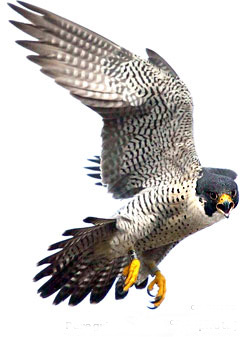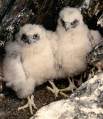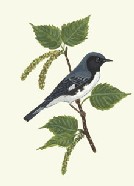Eighty juvenile peregrines had been released in the state by 1991. An additional 12 birds were released in 1996 and 1997 to increase the population in the Southern Appalachian Mountains. Nesting on Whiteside Mountain was first observed in 1988 and has continued each year. There are now approximately 11 nesting pairs of peregrines in North Carolina. Whiteside has been the most successful nesting site in the state, with 39 chicks fledged from the site in the last 18 years. Although the U.S. Fish and Wildlife Service removed the peregrine from the Federal Endangered Species list in 1999, it remains protected under the N.C. Endangered Species law and at the federal level by the Migratory Bird Treaty Act.
Survival of peregrines in N.C. remains tenuous. There are few nesting pairs and the mortality rate for young birds is high. All can help by considering the following: A) Donate to the N.C. Nongame and Endangered Wildlife Fund (1722 Mail Service Center, Raleigh, N.C. 27699 – www.ncwildlife.org) B) Limit use of pesticides and herbicides whenever possible to prevent risk of environmental pollution C) Avoid rock climbing in areas where peregrines nest during their breeding season, February through June - The area on Whiteside where peregrines nest is closed for rock climbing during this period D) Join Highlands Plateau Audubon, www.main.nc.us/nas-hpc, or other conservation organizations to learn more about peregrines and related conservation issues.
Whiteside Mountain Peregrine Falcons
Peregrine Falcons once again nested successfully this spring on Whiteside Mountain. Volunteers from Highlands Plateau Audubon participated with personnel from the Nongame Division of the N.C. Wildlife Resources Commission in monitoring the nesting area. Two young were fledged and began flying in late May.
Peregrines are fast flyers and may reach speeds greater than 200 mph in a dive. They prey on birds that range in size from songbirds to waterfowl, which are captured in flight. In western North Carolina, small to medium sized, slow-moving birds such as blue jays and grackles comprise the bulk of their diet. Pairs mate for life and require large territories. They nest on sheltered ledges on steep cliffs that provide protection from nest predators and precipitation, but in urban areas they may nest on tall buildings or bridges. Given their large territorial requirements, breeding pairs are widely dispersed. In western NC, the two closest nest sites are over 5 miles apart.
Peregrines nested regularly in North Carolina until the 1950’s when they disappeared from the entire eastern U.S. Their disappearance from the eastern U.S., as well as their decline in large areas of the western U.S. and Europe were caused by environmental contaminants, including the pesticides DDT and dieldrin.
The passage of these pesticides from water and insects to small birds and then to the peregrines resulted in high tissue concentrations in the falcons. The pesticide dieldrin killed many birds directly, while DDT interfered with calcification of eggshells. The latter resulted in thin eggshells that were crushed during incubation. In 1970, the U.S. Fish and Wildlife Service listed the Peregrine Falcon as endangered under the Endangered Species Conservation Act of 1969, the precursor of the 1973 Endangered Species Act.
Recognizing the effect of DDT, the Environmental Protection Agency banned the pesticide from use in the U.S. in 1972. Attempts at restoration of peregrines began in 1974 with the first release of captive bred falcons. The N. C. Wildlife Resources Commission began releases in 1984.




